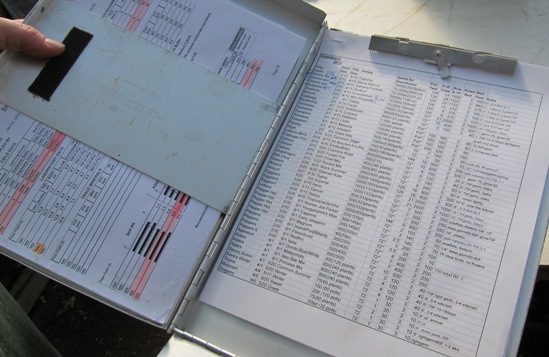A successful season begins with good planning.
One of the greatest challenges of running a CSA is producing a steady flow of an endlessly changing variety of vegetables for an entire season. Dealing with the unique needs of dozens of crops and hundreds of different varieties can be overwhelming. CSA farming also requires growing multiple successions of many crops in order to ensure a long, uninterrupted harvest. The key to dealing with these challenges is developing a good growing plan before the season.
The crop plan is the foundation upon which a successful season is built. We face innumerable challenges every year that are beyond our control. Pest and disease outbreaks, along with weather fluctuations, ultimately determine the abundance of the harvest. With so many factors beyond our control, farmers have to exercise the best management practices possible for the factors we can control. Developing a good crop plan before we ever put a seed in the ground gives us the greatest chance of overcoming the challenges that every season is sure to bring.
Crop planning takes the form of Excel spreadsheets on our farm. We generally take about a week in January to develop our crop, field, and greenhouse plans. Every year, we use our notes and experiences from the previous season to make alterations to our crop plans. We keep a notebook full of information on harvest dates, amounts, and general crop performance. Over the years, this constant tweaking has refined our crop plan to ideally suit our farm.
The master crop plan lists every crop we will grow including the variety, seeding and transplanting dates, and space requirements. Space requirements are listed as bed feet, rows per bed, and total row feet needed to grow each crop. Most of these crops also include multiple planting successions with the same data, and we note whether a crop is to be direct seeded or started in the greenhouse. If a crop will be started in the greenhouse, we include the in-row spacing between plants in the field, which allows us to determine how many plants and seeds we will need.
The master crop plan is then used to create our field plan. First, we use a field map which contains the cropping history of each field to determine where each crop family will be planted this year. Our field map also lists the amount and length of the beds for each field. We then take the crop entries from the crop plan and cut and paste them into the designated fields within the field plan. We add a column to assign a bed number to each crop. This creates a virtual map of the field with every bed numbered and all crops and planting dates allotted. We also include relevant information such as transplant spacing or seeder settings for each crop. Finally, we add a column for notes, where we can add any additional crop-specific information that we feel necessary.
The greenhouse plan is also built from the master crop plan. We list all crops that will be started in the greenhouse in order of seeding date. Here we also add information specific to the greenhouse such as what type and how many of each planting flat we will need. We note whether or not a crop will be started in a seeding flat and then transplanted on to a cell tray. Again, we add a notes column for any vital information, such as crop germination requirements. This plan helps us determine our needs for greenhouse supplies beyond just the seeds before the planting season even begins.
These are examples of the types of crop planning we have found most useful on our farm. Crop plans in general, particularly spreadsheets, can be tailored to be as detailed and smart as you feel necessary. We’ve decided to build plans that include only the most pertinent information. They do not contain a lot of formulas, and we make many changes manually through cutting, pasting, and editing. The key is to make plans that you are comfortable using and that will satisfy your specific needs.

While our crop plans are rather basic, they are still a core tool that we use daily. We carry a clipboard with our field and greenhouse plans in the farm truck at all times, and these plans serve as our seasonal growing guide. We never have to worry about what needs to be planted where and when. Our employees also carry a copy of the plans so they can complete whatever task needs to be done with minimal supervision. Having a good plan allows us to concentrate on the job at hand, producing the best crop possible with the most efficient use of our time and resources.
We had so many requests from readers for sample plans that we asked the Goods if they would be willing to share some more details from their actual documents. They were gracious enough to provide the following snips straight from their farm to yours…
Sample spreadsheets from The Good Farm

